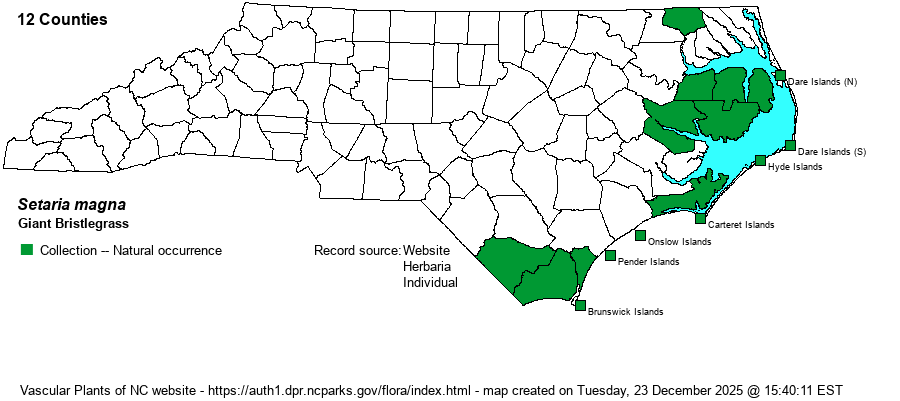| Author | Grisebach | |
| Distribution | Outer Banks, barrier islands, and outer Coastal Plain.
Coastal Plain, NJ to southern FL, southeastern TX, and southeastern AR. West Indies, Mex., Costa Rica. | |
| Abundance | Frequent throughout, except perhaps in the Currituck Sound vicinity (where there are no collections from Currituck County). The website editors feel that the S2S3 State Rank of the NCNHP is too conservative; we suggest S3S4. | |
| Habitat | Brackish marshes, fresh tidal marshes, interdune ponds and marshes, margins of tidal creeks. | |
| Phenology | Flowering and fruiting August-October. | |
| Identification | As the name Giant Bristlegrass implies, this is our tallest and most robust bristlegrass, reportedly up to 18 feet tall (FNA), but in NC usually 5-10 feet -- still one of the taller herbaceous species in the state. The bristles are very long (10-20 mm) and give the inflorescence a foxtail look. This is an annual: from seedling to fruit all in a single growing season. This is a quite conspicuous species of our coastal marshes owing to its great height and long and often gracefully curved inflorescence. | |
| Taxonomic Comments | None
The inflorescences of bristlegrasses look like bottlebrushes, due to the numerous bristles that stick out sideways or that angle upward. Two of our 3 native species are annuals; S. parviflora is perennial. When using keys, make sure to have mature fruiting plants and a dissecting scope to see such features as the surface texture on lemmas, number of bristles per spikelet, etc. | |
| Other Common Name(s) | Giant Foxtail is most frequently used in NC, but most references use the common name of Giant Bristlegrass | |
| State Rank | S2S3 [S3S4] | |
| Global Rank | G4G5 | |
| State Status | | |
| US Status | | |
| USACE-agcp | FACW link |
| USACE-emp | FACW link |

